WEIGHT LOSS
2.0

What’s next for the companies at the forefront of fighting global obesity?

2.0

What’s next for the companies at the forefront of fighting global obesity?
In Asia, life and business move fast. To invest here successfully, you need local knowledge.
abrdn has had investment teams in Asia for over 40 years. So we get to know markets, companies, trends and innovations first hand. And you get to select from investment trusts featuring the most compelling Asia opportunities we can find.
To harness the full potential of Asia, explore our Asian investment trusts on our website.
Please remember, the value of shares and the income from them can go down as well as up and you may get back less than the amount invested. Asian funds may invest in emerging markets which can carry more risk than developed markets.

06 Entain shares plumb four-year low after latest profit downgrade
07 McDonald’s sales drop shows customers are no longer ‘lovin’ it’ 08 Bumper share buyback unveiled by IT reseller Computacenter
08 MicroStrategy set for 10-for-one share split
09 The biggest gainer on the S&P 500 this year is up 145%, and it isn’t Nvidia
09 No pain relief for shareholders in consumer goods group Reckitt Benckiser
10 Can Coca-Cola HBC serve up some upgrades fizz?
11 Disney needs to deliver some turnaround magic
12 Fed likely to leave rates unchanged this week due to mixed data
13 Crisis overblown, time to buy CrowdStrike
15 The best-performing UK investment trust over three years isn’t tech UPDATES
16 Why Unilever’s turnaround story is alive and well
17 Why is Canal+ looking to list in London?
19 COVER STORY
Weight loss 2.0
What’s next for the companies at the forefront of fighting global obesity?
25 Why are high-yield ‘bond proxies’ not outperforming the market? 28 EDUCATION
Why investors should focus on ROCE and ROIC 31 DAN COATSWORTH
Why it’s time for gold miners to play catch-up after metal price rally
33 FINANCE
Dark days for active fund managers
35 EDITOR’S VIEW
Are investors asking themselves the wrong questions about rate cuts?
37 INDEX
Shares, funds, ETFs and investment trusts in this issue 31 25 33 19





1
What lies ahead for the companies fighting obesity?
The runaway success of the first drugs to market has not only attracted competition but also the ire of politicians who are demanding price cuts. We look at the prospects for the companies leading the charge.

2
What is ROCE and why should it matter to investors?
When you own shares in a company the return it earns on your capital ultimately dictates the level of income and dividends you receive.
Did you know that we publish daily news stories on our website as bonus content? These articles do not appear in the magazine so make sure you keep abreast of market activities by visiting our website on a regular basis.
Over the past week we’ve written a variety of news stories online that do not appear in this magazine, including:
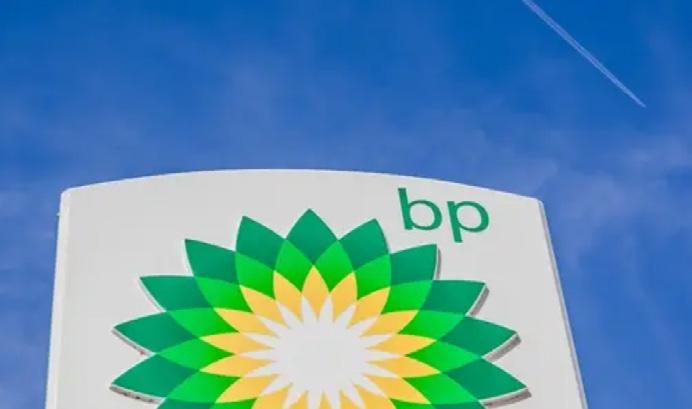


3
Are active managers an endangered species?
The latest AJ Bell survey of active vs passive managers paints an unflattering picture for the fund industry but not all markets are created equal.
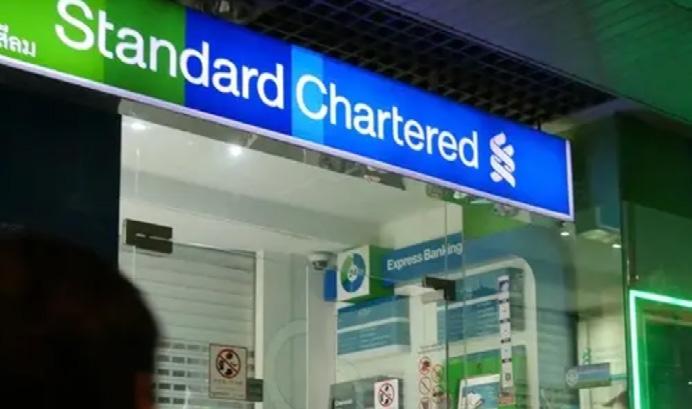

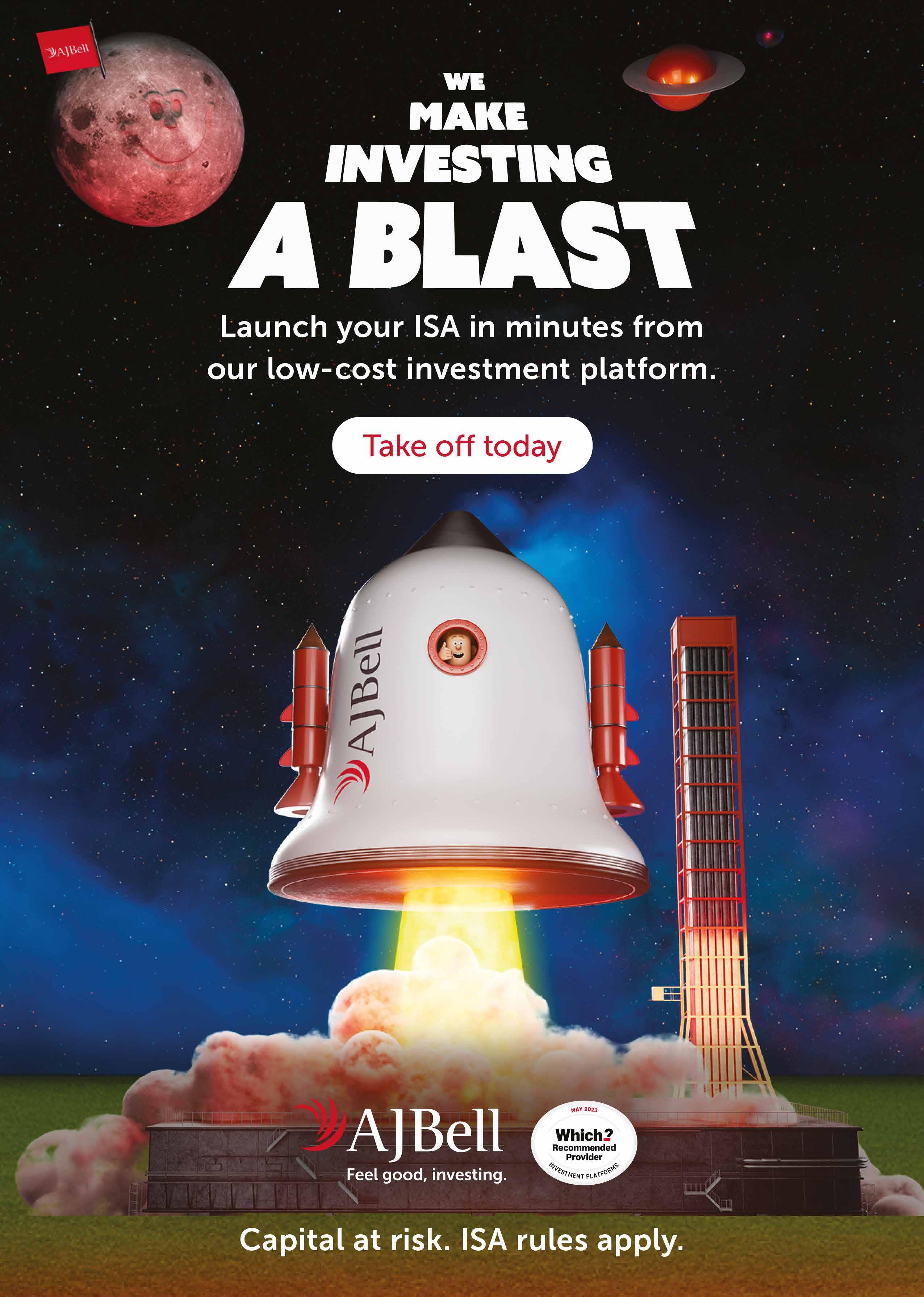
Activists are urging change to fix poor
Shares in embattled Ladbrokes and Coral owner Entain (ENT) plunged by almost a tenth on Monday (29 July), plumbing new four-year lows after the gambling giant’s US joint-venture partner BetMGM said it expected to deploy ‘greater than expected’ marketing in iGaming the back half of the year.
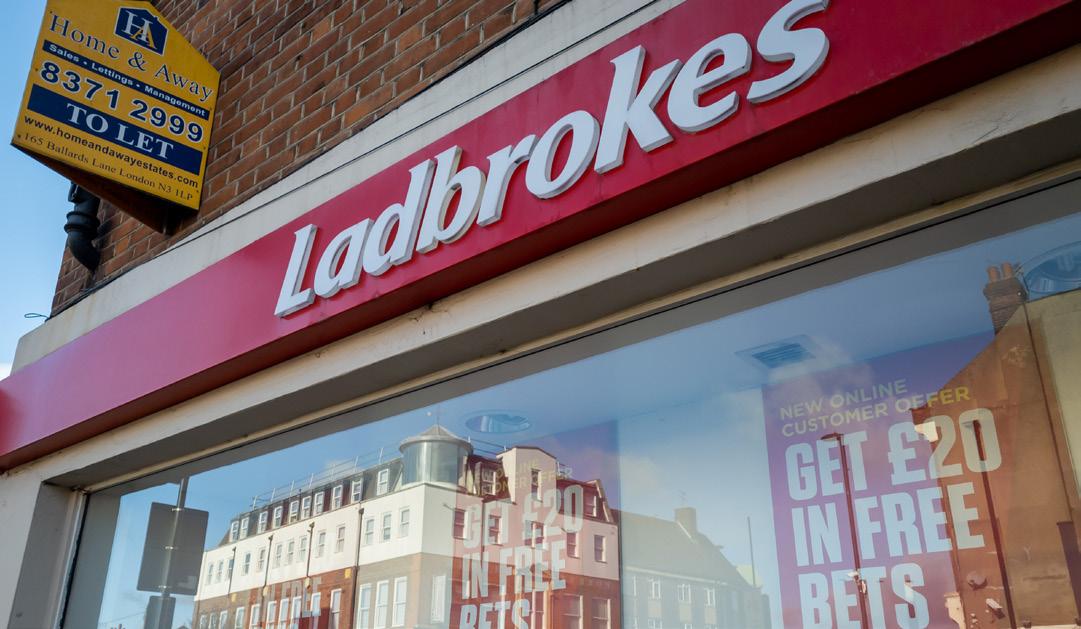
founder Jerry Sandler was appointed to Entain’s board in January and which has repeatedly urged the company to sell all or part of its share in the BetMGM joint venture.
Part of its criticism stems from Entain turning down a takeover offer in 2021 from its joint venture partner MGM Resorts International (MGM:NYSE) pitched at £13.85 per share, more than two times the current share price.
Shares magazine • Source: LSEG
This means the business, currently the thirdlargest US gambling company by revenue, is now expected to post another loss in the second half of the year in line with the £123 million it posted in the first six months.
While management put a brave face on the announcement, highlighting the need to maximise continued strength and attractive returns from iGaming, the upshot is medium-term profitability for the US business has been delayed.
That may not sound too bad but the problem for investors is it blows a hole in analysts’ consensus expectations, implying a 25% hit to current 2024 EPS (earnings per share) according to analysts at Jefferies.
More concerning for investors is the knock-on effect on future years. The previous guidance of $500 million EBITDA (earnings before interest, tax, depreciation and amortisation) in 2026 has morphed into a vague ‘in coming years’.
The latest setback will give further ammunition to activist investor Eminence Capital, whose
However, that pales into significance compared to a proposed cash and share offer worth circa £28 per share from fantasy sports-betting firm DraftKings (DKNG:NASDAQ) which the board also rejected and was eventually withdrawn.
The chief executive at the time of these tumultuous events was Jette Nygaard-Anderson, who left the business abruptly in December 2023.
The resignation followed Entain’s £585.5 million settlement of a Crown Prosecution case relating to historic activities in Turkey undertaken by prior management. Previous chief executive Kenny Alexander abruptly resigned ahead of the widening HMRC investigation.
His replacement Shay Segev was also packing his bags before too long underlining the lack of continuity at the top of the company.
Investors will be hoping for some stability with the arrival of Gavin Isaacs, who was appointed as new chief executive on 22 July.
Isaacs is the former head of US-based lottery games and betting firm Scientific Games Corp and has 25 years’ industry experience including a stint at DraftKings, which may lead to speculation of another takeover attempt in time. [MG]
Company forced to rethink pricing as consumers cut back on dining out
Sales at McDonald’s (MCD:NYSE) fell for the first time in three years in the second quarter as the fast-food giant fell victim to consumers cutting back on eating out.
For the three months to the end of 30 June, McDonald’s reported a 1% fall in global comparable sales as diners choked at the high cost of its burgers, fries and soft drinks.
In the US, same-store sales fell by 0.7% as value meals failed to entice customers back to the fastfood giant. McDonald’s said foot traffic to its US restaurants actually fell during the quarter.
Revenue of $6.49 billion was flat on the same quarter last year, but net income fell 12% to $2.02 billion compared to $2.31 billion last year missing analysts’ forecasts.
McDonald’s said revenue from its International Developmental Licensed markets fell 1.3% due to the continued conflict in the Middle East and negative comparable sales in China, while comparison sales in Latin America and Japan were more positive.
The firm blamed the rising cost of ingredients, energy and packaging for hiking its prices over the past couple of years, but chief executive Chris Kempczinski recognised consumers were becoming ‘more discriminating with their spend’.
In an attempt to lure more low-income customers back to its restaurants, the firm launched a meal deal across the US in June
allowing diners to buy a McDouble or a McChicken along with small fries, four-piece McNuggets and a small fountain drink for $5.
The deal was meant to last until the end of July but many sites are considering rolling it out into August to generate more sales.
The dip in McDonald’s second-quarter earnings came as the US Conference Board’s consumer confidence index showed another fall to 100.4 last month from a downwardly-revised 101.3 in May.
McDonald’s shares ended the day up 3.7% at $241, although that still leaves them down 12% year-to-date.
Analysts have attributed this ‘spending fatigue’ to sticky inflation, pandemic savings running out and Covid stimulus cheques being spent.
The escalating price of the global fast-food giant’s signature Big Mac sandwich, especially outside its home market, hasn’t helped McDonald’s results in recent quarters.
According to the Big Mac Index, created by The Economist in 1986 to compare the price of the popular burger in dollars across 13 countries, the most expensive Big Mac is in Switzerland and costs $8.17 or 44% more than the exact same product in the US.
After Switzerland, Norway is the second-most expensive country at $7.14, while Britain is seventh at $5.71, not far above the US. [SG]

Extended lead times among reasons for short-term pullback from expansion plans
International IT reseller Computacenter (CCC) has unveiled a new share buyback programme worth £200 million, larger than analysts had expected and worth about 7% of its issued share capital.
Buying back shares in the company when the stock is seen as discounted has been a regular feature of Computacenter’s investment modus operandi for years, a point noted by Liberum’s Harvey Robinson: ‘This continues the company’s exceptional track record of returning capital to shareholders with over £619 million in last 10 years.’
overseas operations during the past 18-months or so, mostly in the US, yet management seems to have concluded that the emergence of several headwinds means pushing ahead with expansion may not be in the best interests of shareholders in the short-term.
This became apparent in a first-half trading update which showed adjusted pre-tax profit falling 29% to around £87 million. According to Megabuyte analyst Indraneel Arampatta, this reflected a tough comparable half-year 2023, which was boosted by major one-off hardware deals, longer fulfilment lead times as large orders (particularly in North America) got pushed into the second half, and a £2 million currency translation impact.

Computacenter has been investing in its
Computacenter shares are currently trading at £26.83.
Stock division aims to make buying the shares easier for small investors
US-listed software analytics and bitcoin hoarder MicroStrategy (MSTR:NASDAQ) is primed to pull the trigger on a 10-for-one stock split after the close of trading tonight (1 Aug).
All shareholders will receive nine additional shares for each one they own, which are expected to be distributed after markets close on 7 August, with trading starting from 8 August. Investors have become familiar with share splits after some of the world’s biggest and most popular companies chose to sub-divide their
equity, including Nvidia (NVDA:NASDAQ), Walmart (WMT:NYSE) and Broadcom (AVGO:NASDAQ) this year, plus Apple (AAPL:NASDAQ), Amazon (AMZN:NASDAQ), Tesla (TSLA:NASDAQ) and Alphabet (GOOG:NASDAQ) since 2020.
MicroStrategy, led by founder and executive chairman Michael Saylor, has become a bitcoin proxy for thousands of investors after hoarding the world’s largest collection of the cryptocurrency among listed businesses.
As of end June 2024, the company is believed to have amassed 226,331 bitcoins, worth an estimated $15 billion, about half the company’s $29.9 billion market value.
The firm’s strategy is to borrow money to buy bitcoin, and repay the fiat debt by selling less bitcoin in the future, a plan that relies on Bitcoin continuing to increase in value.
Data from the company in April 2024 says MicroStrategy paid an average $35,180 per bitcoin, versus the current $66,506 market price. [SF]
WHAT IS THE BEST performing S&P 500 stock so far this year? AI (artificial intelligence) chip champ Nvidia (NVDA:NASDAQ) maybe? Weight loss wonder Eli Lilly (LLY:NYSE) or bitcoin proxy MicroStrategy (MSTR:NASDAQ) perhaps? No, no, and no.
The gong goes to another AI story stock, Super Micro Computer (SMCI:NASDAQ), even after the past month’s 16% decline. Super Micro is finding a home in ever more investor portfolios thanks to its innovative, energy-efficient, liquid super-cooled servers and storage solutions.
The San Jose, California,
company’s clever kit includes highdensity servers and specialised hardware accelerators, as explained in Shares recent in-depth feature
These are effectively processorpacked industrial super-computers with the capacity to rapidly acclerate certain functions on demand, perfect for new AI applications that need superfast access to enormous data sets.
Up 145% since the start of 2024, it one of just two stocks to run-up triple-digit gains this year – you can probably guess that Nvidia is the other (+127%).
Nothing company-specific is
FROM BEING ONE of the hottest properties in the market prepandemic, and having had a ‘good crisis’ as it were thanks to its hygiene division, global personal and household products group Reckitt Benckiser (RKT) now finds itself in the investment equivalent of the bargain bin.
Shares in the Nurofen-to-Airwickmaker hit a new 10-year low this week after investors reacted badly to a US court ruling against rival infant formula-maker Abbott
A Missouri court ordered the US pharma giant to pay $495 million in damages to a woman who claimed its formula caused her daughter to develop a dangerous bowel disease.
The case is one of almost 1,000 filed against Abbot Labs and Enfamilmaker Reckitt in recent years.
In March this year, Reckitt shares plummeted 15% in a day after a US jury awarded another plaintiff $60 million in damages, a verdict the firm is contesting.

behind the recent stock drag, it’s more down to the wider market edging away from growth and risk assets in the wake of sky-high expectations for second-quarter earnings, which have been decent, if not knockout so far.
Super Micro reports its own fiscal Q4 earnings to end-June next week (6 Aug), presenting a great chance to address the market’s capricious enthusiasm. [SF]
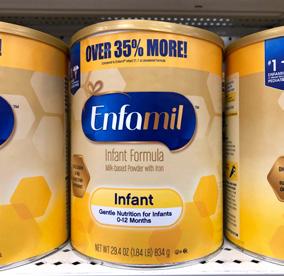
Analysts at JPMorgan said based on previous litigation cases involving talc and opioids the settlement could imply a total settlement cost to the UK firm of between $500 million and $1.5 billion.
The news was a double blow to investors after Reckitt shares rallied last week on a promise to streamline its business. [IC]
INTERIMS
6 August: InterContinental Hotels Group, SIG, Spirent Communications, Travis Perkins, Genel Energy, Abrdn
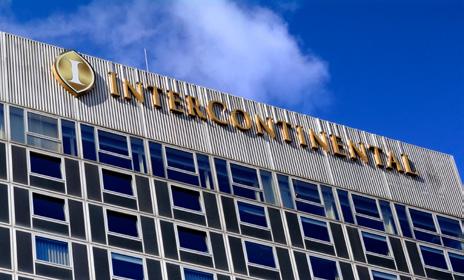
7 August: Glencore, Ibstock, WPP, LSL Property Services, Ferrexpo
8 August: Mears, Entain, Derwent London, Hikma Pharmaceuticals, Spirax, Serco, Beazley

The Coca-Cola Company’s quarterly earnings beat and raised outlook augurs well
Investors can expect some earnings fizz and potentially a round of upgrades when Coca-Cola HBC (CCH) serves up first half results on 7 August.
The positive setup heading into the print for the consumer packaged goods group, a strategic bottling partner of The Coca-Cola Company (KO:NYSE), follows forecast-beating second quarter earnings (23 July) and raised guidance from the latter, which controls Coke and other brands and sells concentrates and syrups to CocaCola HBC and other bottling partners.
The forecast beat from New Yorklisted Coke demonstrates global demand for its iconic Coca-Cola brand and broader drinks portfolio remains resilient.
Year-to-date, shares in geographically-diversified CocaCola HBC, which operates everywhere from Greece, Italy and Poland to Ukraine, Egypt and Nigeria, are up more than 20%, so positive revisions will probably be needed to sustain this momentum.
On 30 April, Coca-Cola HBC reiterated its 2024 guidance for organic sales growth of 6% to 7% and organic EBIT (earnings before interest and tax) growth in the 3% to 9% range as the Schweppes, Coke Zero and Finlandia Vodka seller highlighted a strong start to the year.
Organic revenues bubbled up 12.6% in the first quarter, led by Coca-Cola HBC’s ‘strategic priority’ categories of Sparkling, Energy and Coffee. CEO Zoran Bogdanovic called out another quarter of volume growth and market share gains, with emerging markets proving the star turn. [JC]
The entertainment giant has cut costs to combat challenges in streaming, parks and movies
Bob Iger was summoned out of retirement in 2022 to get iconic media company Walt Disney (DIS:NYSE) whirring again, but there is still much for the chief executive to do to turn round the fortunes of the ‘House of Mouse’.
Cost-cutting progress, streaming business subscriptions and the outlook for the important Parks business will all be scrutinised when Disney delivers third-quarter results on 7 August, when any undershooting of the $1.18 of earnings per share and $23.03 billion of revenue the market is looking for could trigger heavy selling.
Back in May, Disney reported double-digit adjusted earnings per share growth for the second quarter along with a first profitable quarter for its direct-to-consumer (DTC) business, which includes Disney+. However, these achievements were overshadowed by worries regarding the weaker-than-expected outlook for Parks and guidance for a decline in entertainment streaming subscriptions in Q3 to reflect the summer lull.
Disney hopes to tackle this via the Netflix (NFLX:NASDAQ) model of
preventing password-sharing globally, and Iger stressed his charge remained ‘on track to achieve profitability in our combined streaming businesses in Q4’. Having suffered a series of duds at the box office and straight-tostreaming releases for both its live-action and animated output, investors will be relieved to see ‘Inside Out 2’, the latest release from Disney-owned studio Pixar, proving a summer hit. [JC]
QUARTERLY RESULTS
2 August: Exxon Mobil, Chevron, Linde, PPL
5 August: Berkshire Hathaway, CSX, Williams, ONEOK, Diamondback, Tyson Foods
6 August: Amgen, Caterpillar, Uber Tech, Constellation Energy, Airbnb, Fortinet, Yum! Brands, Fox Corp
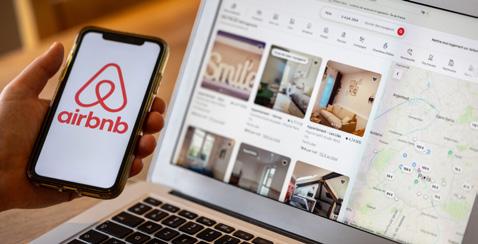
7 August: Walt Disney, Hilton Worldwide, Occidental, Global Payments, Warner Bros Discovery, Marathon Oil, Ralph Lauren

8 August: Eli Lilly, Gilead, Datadog, Expedia, News Corp, Paramount Global

Friday’s unemployment rate will show whether it was right to do so
The US Federal Reserve finds itself in a ‘damned if they do, damned if they don’t’ situation with regard to cutting interest rates as the data on which it depends still doesn’t make a conclusive case for moving from its current position.
Last week’s second-quarter US GDP print showed prices rose less than expected at 2.3% against a forecast of 2.6%, yet the economy expanded at a rate of 2.8% against a forecast of 2% and just 1.4% in the first quarter.
At the same time, personal spending and savings data doesn’t suggest the US consumer is tapped out despite negative commentaries from retailers and consumer goods makers.
Core PCE (personal consumption expenditure)
figures released last week showed inflation running at 2.6% in June, the same level as May, which again doesn’t suggest the economy is heading for a sharp slowdown –Treasury yields and the dollar index were virtually unchanged after the report.

However, there are increasing calls for the Fed to cut rates on 1 August, with former bank governor Bill Dudley arguing it should have cut already.
That view is echoed by Mark Zandi, chief economist of Moody’s Analytics, who points to repeated downward revisions to the jobs figures and stresses in the financial system caused by the inverted yield curve.
‘They seem to be waiting for something to break,’ says Zandi. ‘By that stage it will be too late’.
For the first time in a long time people are discussing the Sahm Rule, an indicator used by the Fed to establish when the economy has entered a recession.
The rule says a recession is likely to have begun when the three-month average of the national unemployment rate (U3) increases by at least 0.5% above its lowest point of the previous 12 months.
That means the unemployment figure on 2 Aug will assume far greater significance than usual and could provoke a sharp negative reaction. [IC]

IT outage drama will pass, and growth retains exciting potential
Market cap: $63 billion
It’s been a rough couple of weeks for CrowdStrike (CRWD:NASDAQ) after what some have called the world’s biggest IT outage caused banks, hospitals, and airports to ‘go dark’. The question for investors now is that following the more than 30% share price crash, is the stock worth buying?
Shares believes the answer is Yes, but investors who do so should be aware of what could go wrong.
First, what actually happened? The massive technology blackout affected millions of users in the early hours of 19 July 2024 after the cyber defence giant released a buggy security update which was missed, causing vital Microsoft (MSFT:NASDAQ) systems to crash.
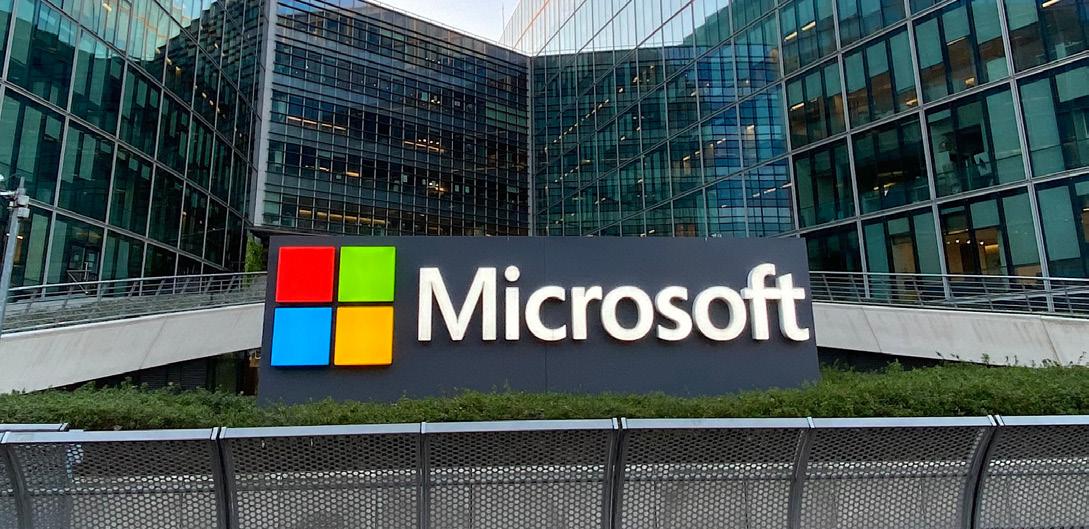
While the company is still investigating the details of what went wrong, this was not a security breach, the firm said, and the faulty update was quickly spotted with fixes released by both CrowdStrike and Microsoft. ‘We find credence in this response, considering that within hours of the outage, companies with operations affected had been able to gradually resume their services’, said
analysts at Morningstar.
Within a few days, 97% of connected devices affected were back up and running, according to CrowdStrike executive chairman George Kurtz.
Arguably, the biggest problem for CrowdStrike ahead will be managing reputational damage, although we can’t rule out compensation payouts and even lawsuits, albeit the latter look highly unlikely.
We know good reputations can take years to build and moments to destroy, but the fact this was not caused by a breach of the company’s defence systems remains encouraging.
After all, it is the robustness of its cyber defences which has kept CrowdStrike at the forefront of the cybersecurity industry for years and made it one of the industry’s hottest stocks to buy. For example, over the last three years, its revenues have grown by around 250% versus roughly 100% for rivals Palo Alto Networks (PANW:NASDAQ) and Fortinet (FTNT:NASDAQ).
This is because CrowdStrike offers a compelling continuous-monitoring cybersecurity proposition. A visit to the cinema is a decent analogy. While some firewall providers do what ushers do, check your ticket then let you pass, CrowdStrike continues to watch you inside the auditorium, and if malicious or odd behaviour is detected the platform can act quickly and isolate it so it doesn’t spread.
‘Channel conversations we had before the outage occurred implied CrowdStrike was taking share and performing ahead of expectations for the quarter’, say analysts at investment bank JPMorgan.
However, post-outage discussions reflected ‘increased uncertainty’ with some deals delayed and partners still assessing the incident’s impact on results for the quarter and momentum for the rest of the year.
These uncertainties may persist for a while, at least for the next couple of quarters. Let’s not sugarcoat it, until financial markets have evidence of the real impact on CrowdStrike’s growth and profits, the stock could remain volatile.
Yet cybersecurity spend isn’t going away, and this event could see boardrooms assign more resources to digital defences as part of multi-supplier deals where more than one provider is recruited.
Revenue ($m)
In short, most analyst responses we have seen continue to see a very bright future for CrowdStrike, even if the near-term remains dogged with uncertainty. Rosenblatt Securities, for example, views this as a temporary setback in an otherwise strong growth trajectory, supported by the company’s solid fundamentals and leading market position.
Analysts remain confident in the company’s ability to learn from this experience, enhance its quality assurance processes and emerge as an even more reliable partner for its customers.
Before the outage, CrowdStrike stock traded on a P/E (price to earnings) multiple close on 80, partly because it made its first ever net profit in the year to 31 January 2024.
This year should see net profit surge, according to post-outage consensus, from $89.3 million last year to $992 million, on $3.98 billion of revenue, primed for more than 20% growth.
By fiscal 2027, forecast net profit could be close to $1.7 billion on more than $6 billion of revenue, implying a P/E of 42 times. We believe this is the sort of long-run growth trajectory which demands a premium valuation and could see the stock rally back to Rosenblatt’s $350 target price over the next 12 to 18 months. [SF]
Literacy Capital has achieved a remarkable 47% compound annual NAV return
Market cap: £310 million
We have been keeping a watchful eye on UK private equity investment trust Literacy Capital (BOOK) for some time, and this week’s quarterly NAV (net asset value) and trading update has finally convinced us to go nap.
The trust was set up in 2017 and listed in June 2021, since when its NAV has risen at a 47% compound annual rate making it the bestperforming UK listed trust over that period.
The trust says its purpose is ‘to invest in and support UK companies and help their management teams to achieve long-term success’, and its closedend, permanent capital structure means it can work as a ‘long-term, highly ambitious partner’.
The company is focused on smaller businesses where its expertise can make a significant contribution to their size and value, in turn generating superior returns for shareholders.
It also has a charitable mission, helping disadvantaged children in the UK learn to read, and donates the equivalent of 0.9% of NAV every year with total donations since 2017 having reached £10 million.

Since listing, net assets have increased by 225% and the share price has increased by 230% against a 22% return for the FTSE All-Share and a 2% loss for the FTSE investment company index.
So why are we recommending the shares now? Over the 12 months to the end of June, the share price has only risen 12.7% - in line with the FTSE All-Share – meaning the trust has de-rated after two years of blistering growth.
Richard Pindar, chief executive of the trust’s manager, accepts there have been ‘some obvious challenges for UK businesses in recent times, but we are confident that our portfolio companies can continue generating further upside, particularly if macroeconomic conditions show signs of improvement’.
In the second quarter, the trust’s largest holding (around 32% of NAV) RCI Group, which provides clinical services and complex care, was the largest contributor to revenue and NAV growth, while flexible office space provider Cubo Work, another top five holding (representing around 6% of NAV), also made ‘a material positive contribution’ due to its rapid expansion and sales success.
No new companies were bought or sold during the quarter but the trust invested £5 million to support existing companies’ growth plans.
The portfolio is continually assessed to see how capital can be recycled, and Pindar says he sees plenty of new investment opportunities to redeploy capital into companies where the founders value the expertise the managers bring. [IC]
Stick with the Persil-to-Sunsilk maker with margins and volume growth improving
Shares flagged the attractions of consumer goods goliath Unilever (ULVR) at £38.19 in January 2024 on the grounds the Dove-toDomestos maker’s intrinsic strengths were underappreciated by the market.
We also hoped new chief executive Hein Schumacher could reinvigorate growth and revitalise the FTSE 100 firm’s share price.
On 15 February, we urged readers to stick with Unilever following full year results (8 February) which revealed a welcome return to volume growth in the year to December 2023.
WHAT HAS HAPPENED TO SINCE WE SAID TO BUY?
Unilever’s shares are 23% up on our entry price, with the planned sale of its struggling ice cream division and a big cost-cutting drive helping to revitalise the stock price following a period of sluggish growth and activist pressure.
First half results (25 July) provided the latest stock price boost, despite second quarter organic sales growth coming in light of expectations. The market welcomed a third consecutive quarter of improving volume growth in


Chart: Shares magazine • Source: LSEG
Q2 as well as a massive upgrade to the full-year underlying operating margin to ‘at least 18%’ with productivity gains filtering through.
Power Brands, which speak for roughly three quarters of group revenue, spearheaded the firsthalf growth with a 5.7% sales advance and volumes up a healthy 4%, suggesting investment behind these products is paying off and consumer demand for big brands is bouncing back.
WHAT SHOULD INVESTORS DO NOW?
This is no time to take profits, with Schumacher putting the company back on a path for growth.
Unilever offers investors a play on emerging markets growth and continues to reward shareholders with progressive dividends and earnings enhancing share buybacks.
Efforts to sell or float the ice cream division, which will enable Unilever to focus on other divisions with stronger growth prospects, are ongoing and investors will want to be on the shareholder register if there is a demerger, since this will give them exposure to storied brands such as Magnum, Cornetto and Ben & Jerry’s in a dedicated, focused, standalone ice cream business. [JC]
French media giant Vivendi plans to float its TV and film operation in the UK
In another sign of the UK market’s recent rehabilitation, French media giant Vivendi (VIV:EPA) has announced it will list its Canal+ TV and film operation in London as part of a broader break-up of the business.
The move may raise some eyebrows given the lack of any obvious ties between Canal+ and these shores. With the departure of Sky, its main listed counterparts will be ITV (ITV) and its cousin from north of the border STV (STVG).
Vivendi has not committed to anything yet and based on what it’s said so far it could be some time before Canal+ lists. The current thinking is a decision could be taken at the end of October 2024 with the aim of putting it to a vote by December where it would need support from a two-thirds majority of shareholders.
Because Vivendi is itself a public company there is at least a decent amount of information out there for prospective investors to prime themselves on Canal+ as a business.
In the first half of 2024 it posted revenue of €3.1 billion, up 4.6% year-on-year, and flat EBITA (earnings before interest, tax and amortisation) of €337 million. This adds up to a 10.9% EBITA margin, whereas in the six months to 30 June ITV generated adjusted EBITA of £212 million against external revenue of £1.6 billion for a 13.3% EBITA margin.
Set against the apparently lower level of profitability, Canal+ is more geographically diversified than ITV and also has its Studio Canal film operation which enjoyed 8.6% revenue growth in the first six months of the year. It is also expected to be largely free of debt when it floats.
Two key components of the firm’s strategy are to continue developing the business internationally – two-thirds of its subscribers are from outside France and growth from international operations was roughly 4.2% in the first half – and improving its


content offering.
To the former end, Canal+ recently agreed to buy MultiChoice, Africa’s largest pay-TV operator, in a $2.9 billion deal, building on its investment in Asian streamer Viu and Scandinavian firm Viaplay.
On the content side, it unveiled a distribution agreement with Warner Bros Discovery in May as well as launching Studiocanal Stories – a new label focused on literary adaptations into films and TV series.
Notably, Vivendi is talking about a secondary listing for Canal+ in Johannesburg, alongside its London quote, linked to the deal for MultiChoice. The group is at pains to point out the decisionmaking centre for Canal+ would remain in France along with its operational teams, with its tax domicile also remaining across the Channel. [TS]

By Tom Sieber Editor

MAGAZINE HELPS YOU TO:

• Learn how the markets work
• Discover new investment opportunities
• Monitor stocks with watchlists
• Explore sectors and themes
• Spot interesting funds and investment trusts
• Build and manage portfolios

IWhat’s next for the companies at the forefront of fighting global obesity?

By Martin Gamble Education Editor
nvestor excitement surrounding weight-loss drugs has arguably been as great if not greater than that seen for everything AI (artificial intelligence) in the last two years.
Market leaders Novo Nordisk (NOVO-B:CPH) and Eli Lilly (LLY:NYSE), makers of Wegovy and Zepbound respectively, have seen their share prices soar as investors seemingly extrapolate their initial success years into the future.
Beneath that sunny narrative there are clouds building in the form of greater competition, increasing scrutiny of the high price of the drugs and new evidence suggesting increased health risks.
This article explores each of these risks to provide a wider context for readers and to answer the question of whether the potential rewards outweigh those risks.
According to healthcare consultancy group IQVIA (IQV:NYSE) there are currently around 120 obesity drugs in development, which speaks to the potential barrage of competition coming down the track.
That is why both Eli Lilly and Novo Nordisk are
investing heavily in new capacity to satisfy the huge demand and stay one step ahead of future competition. Currently demand outstrips supply and is likely to remain that way for the next couple of years.
Lilly has more than doubled its spending on a Lebanon manufacturing site to $9 billion to boost capacity, making it the largest investment in the company’s history.
For its part Novo Nordisk announced plans to invest $6 billion in a Danish site which makes semaglutide, the active ingredient in both Wegovy and Ozempic, which treats Type 2 diabetes.
Production involves a complex fermentation process and according to experts Lilly’s active ingredient is even harder to manufacture. This means new production facilities can take several years to come fully on stream.
As well as producing active ingredients, another bottleneck is the fill-finish process. Both production challenges have seen Lilly and Novo increasingly leaning on outsourced contract manufacturers.
According to the Financial Times, US firms Thermo Fisher Scientific (TMO:NYSE), Catalent
(CTLT:NYSE), Simtra and German-based Vetter control more than half of the fill-finish market.
National Reliance is a US contract manufacturer which sprang up during the pandemic and specialises in fill-finish for injectable cancer drugs. The company will fill Lilly’s Zepbound injector pens at its Cincinnati plant with a total capacity of 200 million doses a year by 2025.
Some experts believe contract manufacturers do not have enough capacity to fully meet the demand from Lilly and Novo which implies little in the way of spare capacity for the next three to five years.
One solution could be daily oral pills rather than weekly injectables, which both companies are developing. Analysts at Barclays believe an oral pill could create its own supply problems given a 50mg dose of Novo’s semaglutide requires 146 times more active ingredient than a weekly injection.
It seems inevitable that such a large potential market will attract competition. Analysts at Berenberg recently upgraded their forecast for the weight-loss market to around $150 billion by 2025,
up from a prior forecast of $125 billion.
The most likely usurpers of the current duopoly (a market controlled by two competitors) according to Berenberg include biotechnology giant Amgen (AMGN:NASDAQ), Roche (ROG:SWX), AstraZeneca (AZN) and Danish biotech Zealand Pharma (ZEAL:CPH).
Amgen is expecting phase three data for its obesity drug candidate MariTide by the end of 2024, which, if approved, could enter the market by 2026.
Phase one data is expected for Roche’s weekly injectable obesity candidate CT-388 as well as its oral version CT-966, while we may also see phase one data from Astra’s oral obesity drug candidate AZD5004 by the end of 2024.
Zealand Pharma has created quite a stir as a potential disrupter in the weight-loss field, helping its shares jump three-fold in the last 12 months.
In June, the company announced positive headline results in an early-stage trial of its obesity drug candidate Petrelintide, an alternative treatment which showed meaningful reductions in body weight with a greater tolerability profile than existing weight loss drugs.
Zealand’s chief medical officer David Kendal says: ‘These results support our conviction that Petrelintide is very well tolerated and can potentially play an important role as an alternative
Berenberg forecasts around 30 million US patients on obesity drug therapy by 2030
to incretin-based therapies for the management of overweight and obesity’.
The company raised $1 billion in fresh equity on 20 June through a private placement to support the development of its novel weight-loss treatment.
Fund managers Ailsa Craig and Marek Poszepczynski at International Biotechnology Trust (IBT) believe the entrance of new players should be positive.
‘In the long term, the entry of these new players should stimulate healthy competition, lead to better treatment options, and potentially result in lower prices for patients,’ they said.
‘Various companies are developing new solutions to address the limitations of current injectable drugs, aiming for improved tolerability, better efficacy, and more convenient administration methods, such as oral options vs the current injectables,’ added the fund managers.
Meanwhile, the two incumbents are not standing still. Novo is expecting phase three data from its latest generation of obesity drug CagriSema by the end of the year. Analysts expect it to leapfrog Lilly’s Zepbound and to deliver greater
weight-loss potential.
In the second half of 2025 Lilly’s oral obesity drug candidate Orforglipron is expected to release phase three data while an improved version of Zepbound is expected the following year, yet again raising the weight-loss bar.
Berenberg believes the current duopoly will remain in place longer term and expects Lilly to have a leading 45% share of the weight-loss market by 2035 followed by Novo at 35% and the rest having to make-do with 20% of the pie.
Fund manager Alex Hunter at Sarasin Partners also believes the duopoly has staying power. Part of his reasoning is that while future iterations of weight-loss drugs will be more effective with fewer side effects, the pace of improvement will be incremental, and less likely to displace incumbents.
There are around 100 million obese people in the US of which only four million currently receive treatment. Berenberg is projecting a third will be taking obesity drugs by 2035 and 40% by 2040.
Novo estimates around a third of patients taking Wegovy suffer from three or more conditions
including cardiovascular disease, sleep apnea (breathing stops and starts during sleep) and liver disease.
Positive late-stage clinical trials suggest weightloss drugs could offer effective treatments for other diseases which Berenberg believes could expand the market further.
For context, in the US there are around 50 million people on statins to treat high cholesterol and 100 million on antihypertensive drugs according to Berenberg.
Outside the US, analysts forecast around 10 million people will be taking obesity drugs by the end of the decade, more than double the number in 2023.
US president Joe Biden and senator Bernie Sanders have called on Novo Nordisk to cut prices of its obesity drug Wegovy and diabetes drug Ozempic.
In an opinion piece written for USA Today, Biden and Sanders said it could cost $411 billion per year assuming only half of obese Americans took Novo Nordisk’s and Eli Lilly’s weight-loss drugs which is $5 billion more than the US spent on all prescription drugs in 2022.
They argue that without political intervention the weight-loss drugs have the potential to bankrupt the US healthcare system.
‘If Novo Nordisk and other pharmaceutical companies refuse to substantially lower prescription drug prices in our country and end their greed, we will do everything within our power to end it for them. Novo Nordisk must substantially reduce the price of Ozempic and Wegovy,’ they said.
Both companies have pushed back. Novo Nordisk said it had reduced the cost of Ozempic and Wegovy by 40% since launch and over 80% of Americans eligible for insurance only pay $25 or less per month.
The drugs cost around $1,000 and $1,349 per month respectively according to the company’s website. Lilly’s diabetes drug Mounjaro costs around $1,100 per month but can be purchased for around $25 per month by customers eligible for the company’s savings card programme.
Berenberg estimates diabetes drugs will attract rebates of 70% by 2027 equating to a net price per month of around $350.
Another potential bump in the road for obesity drugs comes from a new study which suggests increased health risks.
Results of a study released on 25 June by the
Obesity has reached pandemic proportions with the number of sufferers more than doubling since 1990 to 890 million according to the WHO (Worldwide Health Organisation).
There is a growing movement which believes ultra-processed foods or UPFs have contributed to the pandemic. UPFs are not strictly foods, but synthetic industrially processed substances which look, feel and taste like food.
Fund manager Daniel Babington at TAM Asset Management explained to Shares some of the characteristics of UPFs and how they

contribute to weight-gain and related diseases. There is increasing evidence that UFPs interfere with proteins in the gut designed to signal to the brain when the stomach is full, resulting in over consumption. That is primarily due to UPFs having very poor nutrition and characteristics which encourage overconsumption.
For food companies UPFs reduce the cost of production, increase shelf life and enhance flavour and textures. Large food companies have funded research denying any link of UPF to obesity and related diseases like diabetes and cancer.
JAWA Network Open medical journal showed patients taking an earlier version of Novo Nordisk’s diabetes drug Saxenda experienced a decline in bone density in the hips, spine and forearm.
The findings are based on new analysis of a study first published in 2021 which tracked 195 obese participants being treated with Saxenda with some taking exercise and some not taking exercise.
In the group doing exercise and taking the drug, bone density was preserved while those just taking the drug experienced a decline in bone density which can lead to bone fractures.
Associate professor at the University of North Carolina’s school of medicine John Batsis said these types of fractures can lead to ‘increased morbidity and mortality, functional impairment and disability’.
market average does not necessarily mean they are too expensive.
The important consideration is how the potential growth stacks up against valuation and how durable growth turns out to be. In general, higher than average valuations imply stronger and longer growth.

Another potential hurdle for obesity drugs in the US is insurance coverage. IBT fund managers Craig and Poszepczynski observe: ‘Medicare generally does not provide coverage for obesity drugs, and Medicaid coverage varies by state.
‘Pharmaceutical companies do offer patient assistance programs, but inconsistent reimbursement policies and high costs limit access for a significant number of patients.’
Just because the share prices of Novo and Lilly have shot up 468% and 814% respectively over the last five years and trade at premium valuations to the
Fund manager Alex Hunter at Sarasin Partners told Shares he believes investors have got it roughly right, and the valuations are rational. Hunter owns Lilly over Novo based on his view it has a better risk to reward.
A common way to evaluate fastgrowing companies is to compare the forward PE (price to earnings) ratio to expected EPS (earnings per share) growth. Growth investors like Mark Slater use the price to earnings growth or PEG ratio as an indicator of value.
Let’s look at consensus expectations and compare them to valuations, based on the one year forward PE ratio.
Novo trades on a 2024 PE of 41.6 times and is forecast to growth EPS at a compound annual growth rate of 17.5% a year between 2023 and 2028.
Lilly has a forward PE ratio of 65.5 and is forecast to deliver an annualised EPS growth rate of 45% a year over the same period.
Therefore, Novo has a PEG of 2.3 times (41.6/17.5) and Lilly has a PEG of 1.4 times (65.5/45). For reference, the MSCI World index has a PEG of 2.5 times according to Gerrit Smith, fund manager at Stonehage Fleming.
The durability of Novo’s and Lilly’s current dominant market positions will ultimately determine if the shares continue to outperform the market long term.



Why
Looking at the appeal of this type of stock and why it has waned of late
This feature was prompted by a reader question on why ‘bond proxies’ such as insurers Phoenix Group (PHNX) and Aviva (AV.) do not attract more investor attention.
A bond proxy typically refers to a company which has a steadier-than-average income stream and offers a higher-than-average level of income.
Long-term savings and insurance group Phoenix sits on a dividend yield of 10.4% based on an expected 2024 dividend per share of 53.9p while insurer Aviva sits on a forward yield of 7.3% based on an expected payout of 34.7p for 2024.
The reader asks why investors are not taking advantage of these ‘chunky’ yields when 10-year gilt yields have fallen close to 4% as investors anticipate interest rate cuts by the Bank of England.
Some perspective is useful here. When interest
rates were virtually zero before the pandemic there was more incentive for investors to reach for higher yields and take more risk. Today, the situation is very different and there is less reason to take on the higher risk of investing in bond proxies.
Let’s compare some of the risks of investing in stocks for income rather than bonds.
The first point to consider is that government bonds are ultra-safe because they have state backing which means investors can confidently bank on receiving the expected annual income and getting their money back at maturity.
Dividends by contrast are discretionary payments rather than contractual, which makes them far less reliable for income.
While company managements are often wary of cutting dividends or paying too much in relation to annual profit, that is not the same as the iron-clad contract given by government bonds.
Unusually high dividend yields can be a sign that

investors are not confident in the sustainability of the payout or on whether it will be paid at all. That said, an elevated yield can also signal a stock or sector is just out of favour.
Deciding whether a high yield is a so-called value trap, or a genuine investment opportunity requires good judgement and analysis. We discuss the merits of Phoenix shortly.
Another factor to consider is the different risk and return characteristics of stocks versus bonds. Stocks provide the potential for growth which bonds do not, if held to maturity. (Capital gains and losses can occur if a bond is sold before it matures).
The potential for stocks to grow is the main reason investors opt to own shares over bonds, notwithstanding stocks can also provide a growing income.
A rising share price, at some point, requires a growing earnings stream, if it is to be sustainable. Shares which rise without the underlying support of earnings are vulnerable to falling back down or inflicting capital losses.
Some businesses can grow faster than others. Slower growing companies generally payout a higher proportion of their profit to investors through dividends.
The reality is that there is a spectrum of growth and income, from low or ex-growth businesses to super-fast-growing ones like AI champion Nvidia (NVDA:NASDAQ) which does not pay any dividends.
What is important to investors is total return, whether that comes 100% via capital growth or a mixture of growth and income.
Armed with the preceding context, let’s take a closer look at Phoenix to see where it sits on the growth and income spectrum.
Investors should expect stock prices to follow earnings over the long run, so it is not surprising Phoenix shares have tracked a languishing EPS profile over time. Over the six years before the pandemic, Phoenix’s EPS (earnings per share) fell from 75.2p to 68.6p according to Stockopedia data. By contrast dividends per share have grown at a compound annual growth rate of 2.7% a year. The combination of a growing dividend and falling share price has created the current double-digit dividend yield. How sustainable is it?
Analysts are forecasting a 2024 dividend of 53.9p per share which is not fully covered by EPS of 46.9p. That is not necessarily an intractable problem if management expect a recovery in earnings which looks to be the case with forecast 2025 EPS growing 16% to 55.1p.
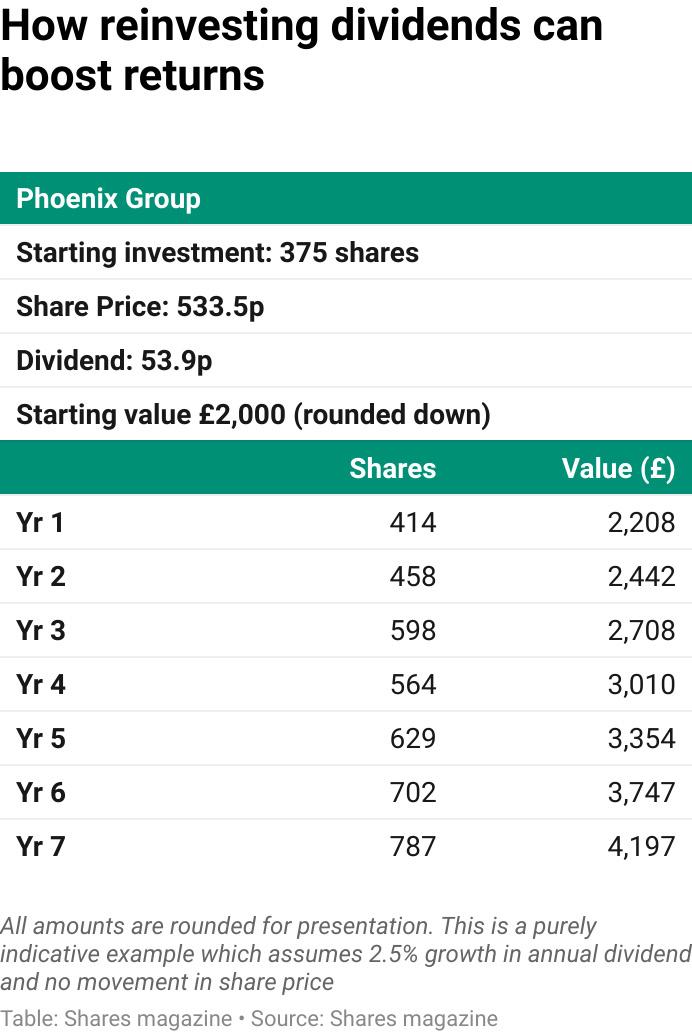
It seems fair to conclude that Phoenix sits at the lower growth, higher income part of the total return spectrum and deserves its bond proxy label given the steady growth in income.
Some investors may look favourably on the extra yield they can earn relative to government bonds and be happy to take on the extra risks. As ever, the
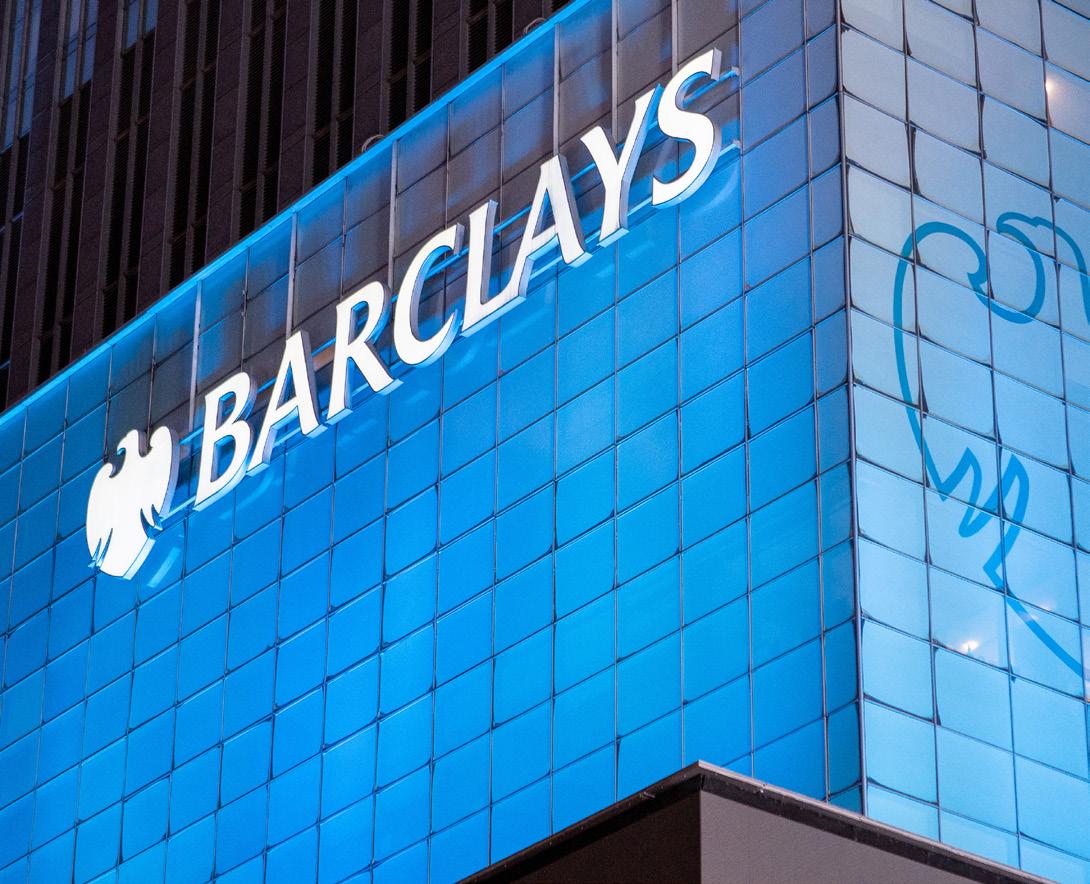
decision comes down to individual risk appetite.
An important thing to understand is that low growth does not always mean low returns, if the starting dividend yield is high.
Reinvesting dividends is an important factor in generating the maximum total return.
In the case of Phoenix, a yield of 10% means an investor could double the value of their investment after around seven years, even if the share price remains unchanged (see table).
It might not be as exciting as watching a share price double in value, but a cash dividend is a ‘bird in the hand’ worth having.
The annual Barclays Equity Gilt Study shows more than half of the stock market’s total return (share price gains plus reinvested dividends) comes from dividends, underscoring how important this income stream is in generating wealth.

By Martin Gamble Education Editor
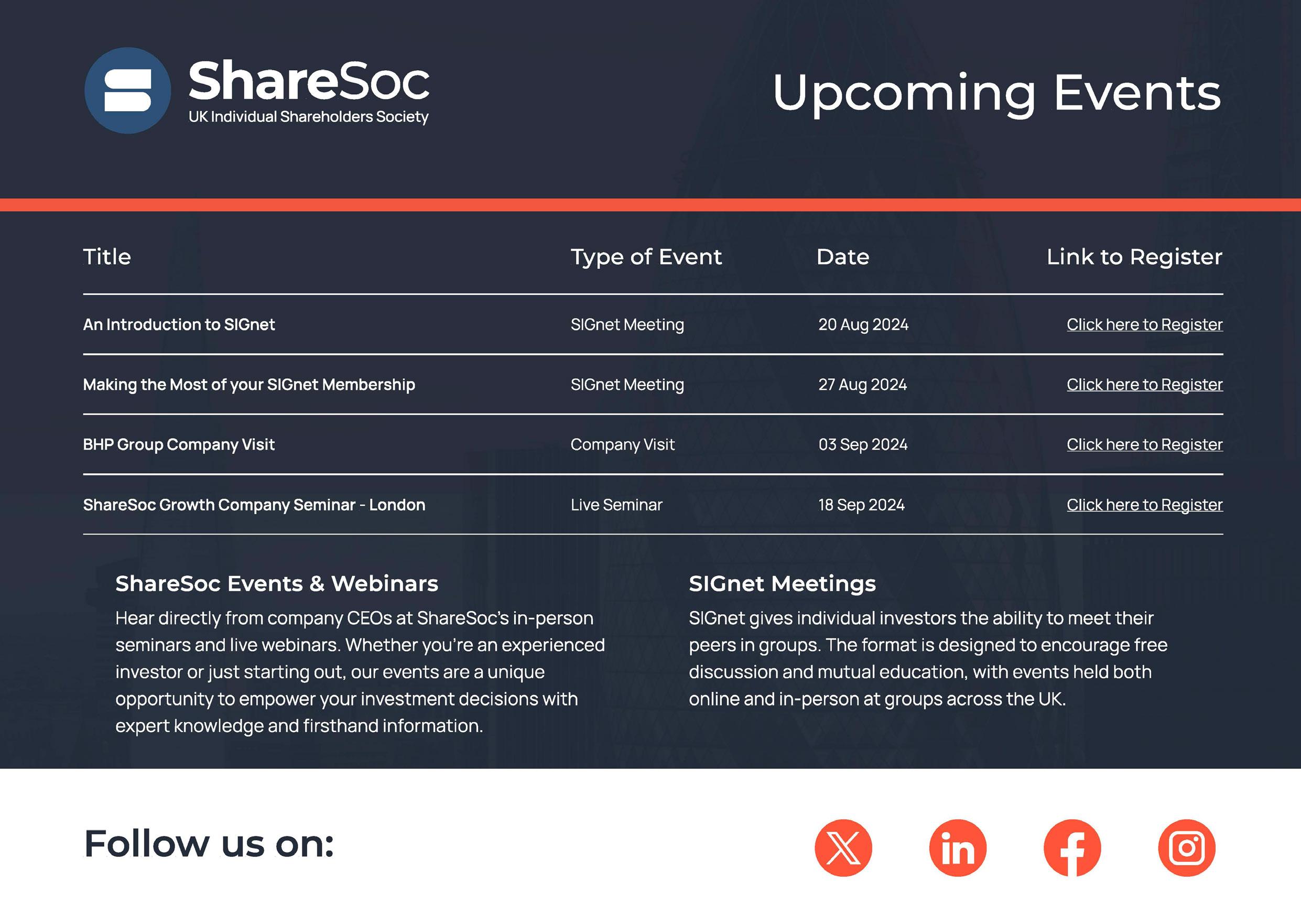

These two metrics tell you whether a company is getting a bang for its buck
Investors looking to put money to work with a company for the long term often employ fundamental analysis, which involves scrutinising financial metrics and analysing financial statements to help them understand how fundamentally strong a company is. While profit margins are a solid indicator of a good or bad business, the margin doesn’t tell you anything about how much money a company actually spent to generate its sales and profits.
This is where two popular ratios used to identify high quality companies come in, namely ROCE (return on capital employed) and ROIC (return on invested capital). In short, these measures tell you how good a company is at getting a decent bang for its buck.
One measure often employed by top fund managers, among them Fundsmith Equity’s (B41YBW7) Terry Smith, and investment analysts,
is the ROCE, which Phil Oakley, author of How To Pick Quality Shares, says is one of the best ways to work out what he describes as a company’s interest rate – i.e. the return it earns on the money invested in its projects. The higher this interest rate is, the better the business tends to be.
Just as you might look for a savings account with the highest or high rate of interest, it makes sense to look for companies that generate high rates of return.
Quality-focused investors such as Warren Buffett and Terry Smith seek out companies with a high and sustainable ROCE or ones they think will eventually have a high ROCE.
To generate value for its shareholders a business should generate a ROCE which is consistently ahead of its weighted average cost of capital (WACC). In plain English, this means it needs to make a bigger return on the money spent funding the business than the average cost
of that funding (from both debt and equity).
A good rule of thumb is that a ROCE of 15% or more is reflective of a decent-quality business and this is almost certain to mean it is generating a return well above its WACC. The higher the percentage figure, the better. It usually signals a company has a competitive advantage over its rivals, as it can make more money from putting the same amount of capital to work. A high double-digit figure often means the company has a defensible edge versus its competitors, for example a strong brand or a unique product.
ROCE measures how effectively a company uses its total capital employed to generate income. It is calculated as the operating profit divided by the capital employed, multiplied by one hundred (see Spirax example).
ROCE is made up of two parts: the return and the capital employed. The most widely-used measure of return is operating profit. The capital employed bit is the money needed to keep a business running and can be measured by combining shareholders’ funds with debt liabilities. Shareholders’ funds, also known as total equity or shareholders’ equity, encompasses all a firm’s assets both tangible (such as a factory) and intangible (anything from a brand to a piece of intellectual property) minus any liabilities. You can find both the shareholders’ equity and a company’s non-current liabilities, an effective proxy for its interest-bearing debt, in the annual accounts statement.
Companies with a high ROCE often have relatively modest capital requirements to fund their growth. This might be because their business is largely conducted online so it doesn’t have the overheads associated with, for example, maintaining and adding to a physical footprint.
Examples include property portal Rightmove (RMV) and second-hand car marketplace Auto Trader (AUTO), while franchise businesses such as Domino’s Pizza (DOM) often generate a high ROCE since their franchisees take on a decent chunk of the capital burden. Companies which consistently increase their ROCE over the years demonstrate they are creating value for their shareholders, making them compelling investments.
Spirax (SPX), the West Country engineering outfit specialising in thermal energy management and niche pumping specialist, reported an operating profit of £284.8 million for the year to December 2023. In the same set of results, it reported shareholders’ equity of £1,156.9 million and non-current liabilities of £1,096.7 million.
CALCULATE THE RETURN
Operating profit = £284.8 million
CALCULATE CAPITAL EMPLOYED
*Shareholders’ equity = £1,156.9 million
*Non-current liabilities = £1,096.7 million
*Shareholders’ equity + non-current liabilities = £2,253.6 million
PUT IT TOGETHER
£284.8 million/£2,253.6 million = 0.126 x 100 = 12.6
ROCE = 12.6
Spirax actually has its 2023 ROCE at 41.6% but it uses a different formula to come up with this number.

A company’s ROIC is different. It is a measure of how efficiently a company generates cash flow compared to how much capital is invested in the company and is calculated by taking its operating profit after tax and dividing by the total amount of capital invested and expressing the result as a percentage.
ROIC is the ultimate measure of profit and performance and a main driver of free cash flow, which is ultimately what investors are after. A company with a higher ROIC will have a lower reinvestment rate than a firm with a lower ROIC, and will need to reinvest less capital to achieve the same level of earnings growth.
High ROIC businesses generate so much free cash flow they can finance their growth internally rather than relying on outside capital to grow. This means less debt or less equity dilution for shareholders and they can invest more in new initiatives to build new moats and new profitable growth streams over time.
ROIC is the favoured metric of Liontrust’s Global Innovation team, co-headed by James Dowey and Storm Uru, who are supported by Clare Pleydell-Bouverie and James O’Connor, a quartet who seek to generate strong returns by investing in innovative companies. Their core belief is innovation is the single most important driver of stock returns. As Pleydell-Bouverie explains: ‘With ROIC, you’ve got profits on the numerator divided by all the investment it takes to generate those profits on the denominator, so it really signals the strength of companies’ barriers as well as their future cash generation.’

Both metrics gauge how well a company’s capital is being employed to run the business, but there are significant differences between the two ratios. ROCE is a more specific return measure than ROIC, but it is only useful when comparing companies within the same industry, whereas ROIC is a bit more flexible, as it can be used to compare products, but also projects and various investment opportunities.
It is also worth noting that because ROCE measures return against the book value of assets, depreciation can affect ROCE even if cash flow is constant. This is not the case with ROIC. Another key difference between ROIC and ROCE is that ROCE is based on pre-tax figures while ROIC is based on figures after tax. Thus, ROCE is more relevant from the company’s perspective, while ROIC is more relevant from the investor’s perspective because it gives them an indication of what they are likely to get as dividends.
David Beggs, fund manager at Sanford DeLand, says both measures ‘should be highly correlated to each other and there is no harm in using both as a point of comparison. If there is a material difference between the two it’s an invitation to dig deeper to understand why.’ Beggs adds: ‘Also, arguably more important than the absolute level of ROIC or ROCE is the incremental return being achieved –that’s looking at how much additional profit is being made on the additional capital that has been invested in the business over say a three or five year period. This can be a great leading indicator.’

By James Crux Funds and Investment Trusts Editor

Improved selling prices and falling inflation could lead to miners trading on higher earnings multiples
The price of gold has a reputation for going through spurts. Over the past five years it has jumped, then pulled back, and then jumped again, on repeat. This year has seen a strong rally for the precious metal price, leading investors to ask if there is more to come.
At $2,424 per ounce, gold returned 17.4% yearto-date which is more than three times as much as the FTSE 100’s 5.5% performance. It is also streets ahead of gold’s 9.5% annualised return over the past 20 years, as calculated by SharePad.
A double-digit return from gold in 2024 is certainly welcome for investors holding the shiny stuff in their portfolio, but what is interesting is how it has done so well in a year when there has not been the typical ‘unwelcome news’ environment that traditionally benefits the metal price.
Think why people like to invest in gold – it is often because the metal is considered to be one of the few assets to hold or grow its value during

times of strife. For example, Russia’s invasion of Ukraine triggered a big rally in the price of gold. It can also be a hedge against extreme events and inflation, the latter partially explaining why it has done well in recent years when the cost of living soared.
THE CHINA EFFECT
Chinese investors have been among the buyers of gold in 2024 as they turn their back on the troubled real estate market and redeploy savings into the precious metal. China’s central bank has also been a major buyer of gold since last year. That has echoes of 2010, which the World Gold Council declared to be ‘an outstanding year’ for the metal when central banks became net buyers of gold for the first time in 21 years.
After feasting on gold for an extended period, it is important to note that China’s central bank refrained from adding gold to its reserves in recent months. That has led investors to wonder if we are now moving to the next phase in the gold market

whereby further price hikes require greater global investment demand.
In June, investment bank BofA predicted gold could hit $3,000 per ounce over the next 12 to 18 months. That implies a 24% return from the price of gold at the time of writing. BofA says achieving this target is dependent on a pick-up in non-commercial demand, which in turn needs the Federal Reserve to start cutting US interest rates. Markets currently believe we will see the first rate cut in September.
Investors can obtain exposure to the gold price through various means. If they do not fancy owning physical gold in the form of coins or bullion, alternatives include tracker funds which mirror the performance of the gold price or actively managed funds which invest in a portfolio of gold miners or gold exploration companies.
Taking the mining route depends on an investor’s appetite for risk as things can go wrong with this industry. In addition to commodity prices being out of miners’ control, gold producers and explorers must also contend with risks associated with operating in remote parts of the world, emerging market governments constantly fiddling with the tax regime around natural resources, and geological challenges such as variable grades of ore.
Certain investors take the view that an investment in gold miner should outperform a rising gold price – while also underperforming when gold is declining in value.
Rob Crayfourd, one of the managers of investment trust Golden Prospect Precious Metals (GPM), explained this concept on a recent episode of the AJ Bell Money & Markets podcast. He said: ‘The miners should have operating leverage. If you say gold is at $2,000 per ounce and costs are $1,000 per ounce, a 10% increase in gold should be a 20% effective increase in margins for the miners and therefore they should outperform gold in a stronger market.’
Interestingly, this concept has not played out as expected in recent years. Miners have lagged the rising gold price because cost inflation has compressed profit margins.
For example, Barrick Gold (GOLD:NYSE) is one of the world’s biggest gold producers and its shares have this year traded on their cheapest price to earnings valuation metric since 2015. The stock currently trades on 13 times forward earnings, lower than the 40 times earnings level which it eclipsed in 2016.
The gold mining industry has had to stomach a significant increase in the cost of things like energy, steel, acid and labour. These inflationary pressures are now starting to ease. We might be at an important turning point for the gold mining sector which could put the industry back on the radar of investors.
The price of gold jumped by 22% from $1,989 per ounce to $2,412 per ounce between midFebruary and mid-April this year and has held firm above $2,300 per ounce ever since. This spike should benefit the next few rounds of quarterly results by gold miners and potentially lead to a re-rating in sector share prices, particularly as the period might also show lower cost inflation and therefore stronger profit margins. There is no guarantee that will happen, but it is something to consider.
‘We should see higher revenues translating into better margins and better free cash flow generation,’ says Crayfourd. ‘Ultimately, that is what drives the miners. They are driven by earnings, not just the headline gold price.’
What AJ Bell’s latest report on passive vehicles vs their actively-managed counterparts reveals
AJ Bell’s latest Manager versus Machine report paints an alarming picture for active managers, who are struggling to beat tracker funds on performance and are losing hands down when it comes to attracting investors’ money.
The report looks at the performance of active funds across seven key equity sectors and compares them to the average passive fund in each sector (see table). Only 35% of active equity funds beat the average passive fund in their sector in the first half of 2024, and the same proportion outperformed over the last 10 years.

It wouldn’t be at all surprising if active managers were starting to feel like an endangered species. Not only is performance flagging, but passive funds are winning the battle for hearts, minds and wallets.
Retail investors have invested £37 billion into tracker funds since the start of 2022, while at the same time withdrawing a staggering £89 billion from active funds based on Investment Association data. These are absolutely unprecedented outflows and compound the performance woes experienced by active managers.
Weak relative performance by active managers isn’t entirely down to stock selection skill, or lack thereof, because some pretty stern headwinds have been battering active funds. Most particularly the continued dominance of big US technology stocks continues to pose existential questions for managers in the key Global and US equity sectors. Taking these two sectors out of our analysis, the proportion of active managers outperforming over a 10-year period rises to a more respectable 46%, within a statistical whisker of the 50% that might be expected in normal conditions.
As Terry Smith points out in his latest letter to Fundsmith Equity (B41YBW7) shareholders, just five big tech companies were responsible for 46% of the returns of the S&P 500 index in the first six months of this year, with Nvidia being responsible for 25% of the returns. Failure to hold a full market weight in the top performing technology stocks has therefore been a costly enterprise for active managers this year, and over the last decade. But to match a passive fund’s exposure, an active US equity fund would now have to hold 32% in the Magnificent Seven stocks, with 7.2% in Microsoft (MSFT:NASDAQ), and 6.6% in each of Apple (AAPL:NASDAQ) and Nvidia (NVDA:NASDAQ). Those are pretty punchy positions for an active manager to adopt, with the unsettling result they would simply be in line with the rest of the market on that portion of their portfolio.
The same problem impacts global fund managers because the S&P 500 now makes up around 70% of global stock market capitalisation. Despite the fact active managers have in large part failed to outperform in the Global and US sectors, investors may be buoyed by the not inconsiderable consolation that absolute returns have been exceptionally strong. The average active US fund has returned 278% over the last ten years, while the average active Global fund has returned 173%.
For the first time our report includes insurance company pension funds, which unfortunately have done even worse than standard funds. Just 24% of active pension funds in our sample outperformed the average passive fund, adjusted for platform charges to put them on a level footing. This includes just 9% of global funds, 14% of US funds and 20% of UK funds. This is just one reading, but there are a number of reasons which might explain the weaker performance of pension funds. Many will have been around for a long time and so may carry higher charges. Some may be closet trackers, making only small deviations from benchmark indices but charging active fees nonetheless. Some
of these funds will be closed to new business, so there may not be a large incentive for providers to invest lots of resources in improving performance, especially when there is low engagement from investors and so little chance of them transferring their pension away.
While it’s easy to laud the low costs and simplicity of index trackers, investors do need to bear in mind that not all passive funds are created equal. Even within the same market, passive funds can elect to follow different benchmarks which can result in performance gaps. For instance, in the global fund sector, a tracker fund following the S&P Global 100 index returned 315% over the last ten years. A passive fund tracking the FTSE World Index by contrast returned 214%. This highlights that tracker funds aren’t one homogenous lump, and passive investors still face some active decisions. While no-one can predict which index is going to perform best, one thing we do know for sure is that higher charges will erode returns. In the UK one fund tracking the FTSE 100 has turned £10,000 into £17,940 over the last decade, and another following precisely the same index has turned that same sum into just £16,400. The former charges just 0.06% per annum, the latter 1.06%. Again, this shows passive investors need to be on their toes. Seeing as funds following the same index should perform very similar jobs, investors holding
expensive tracker funds can achieve better longterm returns by simply switching to a cheaper competitor.
The Manager versus Machine report covers seven equity sectors, and there are areas where passive strategies are less common, or more complex, and where active management can still lay claim to some higher ground, for instance funds targeting income, low volatility or investing in smaller companies. We should also acknowledge that the market return itself is partly a function of active managers collectively allocating capital, and all market participants, including passive funds, benefit from that. The more investment that flows into passive funds, the more money is allocated to companies purely based on their size, and while that has been a winning trade for the last 10 years, it won’t strike most people as a foolproof way to pick winners.
Financial services company AJ Bell referenced in this article owns Shares magazine. The author of this article (Laith Khalaf) and the editor (Tom Sieber) own shares in AJ Bell.


It’s not about the size or the timing, it’s about the fundamentals
Leafing through the second-half outlooks and thought pieces, Shares was struck by a piece not from one of the serried ranks of Wall Street or Square Mile analysts but by a strategist at Boston-based MFS Investment Managers.
Portfolio manager and global investment strategist Robert M. Almeida, Jr suggests investors are too wrapped in the timing and size of Federal Reserve rate cuts and should be looking at the fundamentals of the businesses they own instead.
‘Are ‘When will the first rate cut be?’ and ‘How many times will the Fed cut in 2024?’ the right questions? And do the answers really matter? In 2028, when you’re digesting a five-year attribution analysis of a portfolio, will the timing of that first rate cut be a factor?,’ asks Almeida.
In any case, says the manager, rate cuts are not a panacea for broken businesses: what investors should really be looking at are the drivers of the companies they own and whether rate cuts will help.
‘Perhaps a more relevant question could be why might central banks need to loosen monetary policy? More importantly, if prices of goods and services are falling, whose revenue is being negatively impacted? Are their costs falling too? What will this mean for corporate profits compared with what has been discounted in stock prices?,’ asks Almeida.
‘While the market is happily applying a higher multiple to risk assets because of a potentially lower discount rate, it’s ignoring what mounting weakness may tell us about company fundamentals, and that’s what matters most to asset values.’
Almeida compares the current period with previous peaks in Fed Funds in 2001 and 2008 and the aftermath of the ensuing rate cuts.
In 2001, the Fed was caught out by a sharp growth slowdown and cut rates aggressively from 6% to 1% resulting in a 40% setback for the
The S&P 500 is more expensive than in the tech bubble
S&P 500, while from their peak in early 2008 the Fed again cut rates aggressively from 4.25% and ultimately had to hold at zero, but not before S&P 500 had almost halved.
‘I’m not suggesting we’re facing a drawdown of that magnitude. I’m merely pointing out that central bank interest rate cuts are not a near-term panacea for disappointing operating results,’ offers the manager.
‘While valuations are not at 1990s extremes — which were the highest in US history — analysts’ expectations are for high, single-digit profit growth. Anything that comes in below that will prove disappointing to investors who have alternatives beyond the equity market.’
Here, we beg to differ. On a cyclically-adjusted PE (price-to-earnings) basis, valuations are not just at 1990s extremes but marginally higher, so some stock-taking is surely in order.

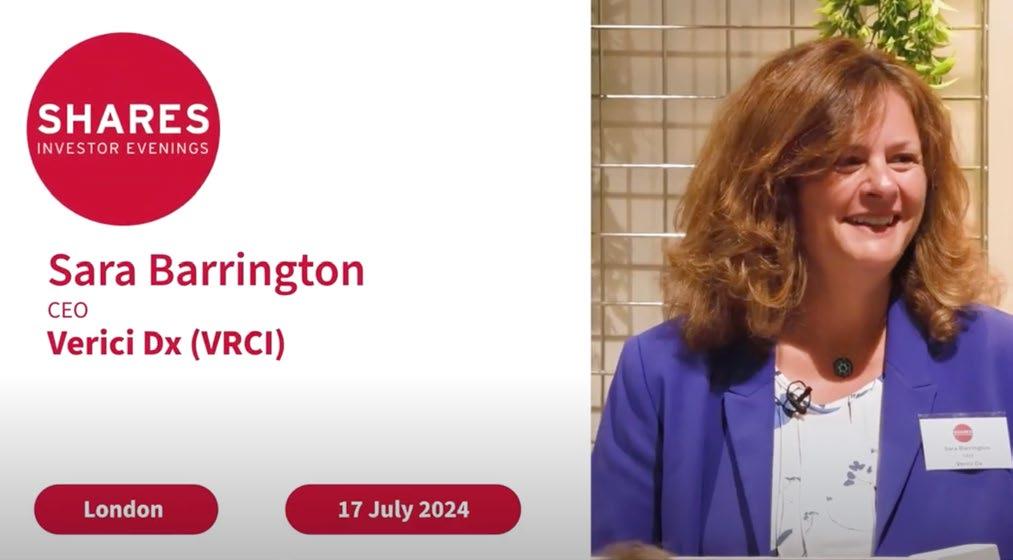

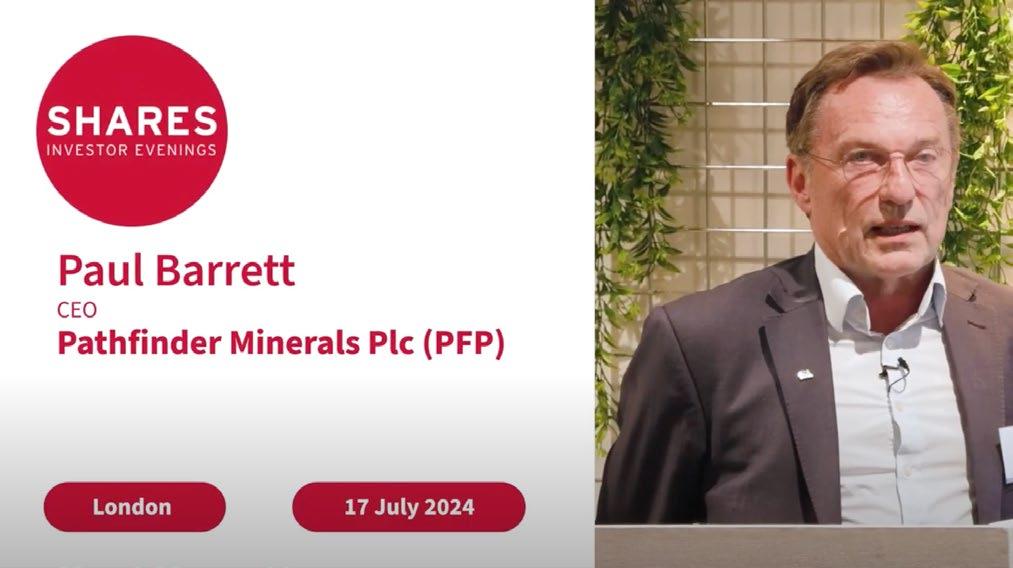
Sara Barrington, CEO
Verici Dx is developing a complementary suite of proprietary, leading-edge tests forming a kidney transplant diagnostics platform for personalised patient and organ response risk to assist clinicians in medical management for improved patient outcomes.
Alex Crooke, Portfolio Manager
The Bankers Investment Trust aims to be a core portfolio holding for its shareholders by focusing on finding the best investment ideas globally in a bid to deliver capital growth and inflation-beating income over the long term. Founded in 1888, the trust has paid a dividend every year and has a 57 year record of raising dividends.
Paul Barrett, CEO
Pathfinder Minerals Plc is a natural resources company is being admitted to AIM following the acquisition of Rome Resources Limited in a reverse takeover. Rome Resources holds tin assets in the DRCongo with encouraging initial drilling results, situated only 8km from the highest grade tin mine in the world.
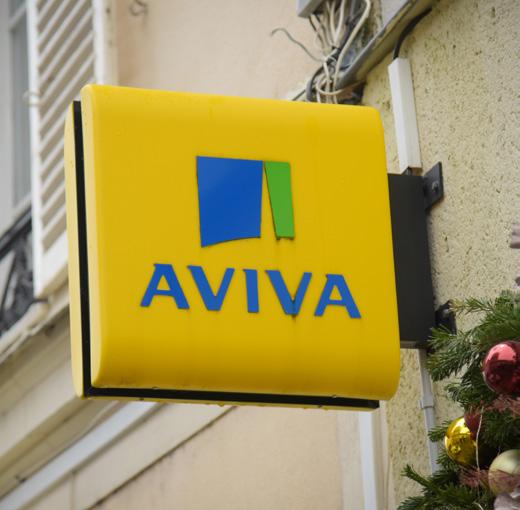

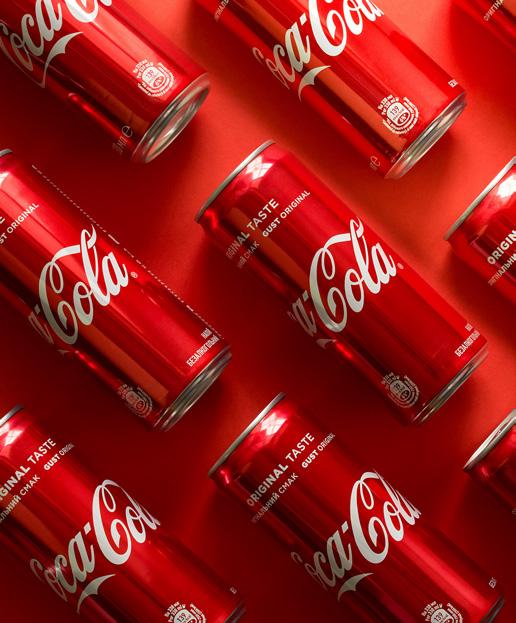


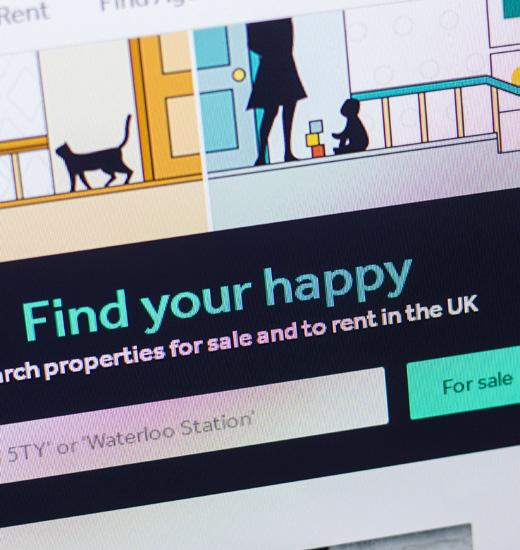







EDITOR: Tom Sieber @SharesMagTom
DEPUTY EDITOR: Ian Conway @SharesMagIan
NEWS EDITOR: Steven Frazer @SharesMagSteve
FUNDS AND INVESTMENT
TRUSTS EDITOR: James Crux @SharesMagJames
EDUCATION EDITOR: Martin Gamble @Chilligg
INVESTMENT WRITER: Sabuhi Gard @sharesmagsabuhi
CONTRIBUTORS:
Daniel Coatsworth
Danni Hewson
Laith Khalaf
Laura Suter
Rachel Vahey
Russ Mould
Shares magazine is published weekly every Thursday (50 times per year) by AJ Bell Media Limited, 49 Southwark Bridge Road, London, SE1 9HH. Company Registration No: 3733852.
All Shares material is copyright. Reproduction in whole or part is not permitted without written permission from the editor.
Shares publishes information and ideas which are of interest to investors. It does not provide advice in relation to investments or any other financial matters. Comments published in Shares must not be relied upon by readers when they make their investment decisions. Investors who require advice should consult a properly qualified independent adviser. Shares, its staff and AJ Bell Media Limited do not, under any circumstances, accept liability for losses suffered by readers as a result of their investment decisions.
Members of staff of Shares may hold shares in companies mentioned in the magazine. This could create a conflict of interests. Where such a conflict exists it will be disclosed. Shares adheres to a strict code of conduct for reporters, as set out below.
1. In keeping with the existing practice, reporters who intend to write about any securities, derivatives or positions with spread betting organisations that they have an interest in should first clear their writing with the editor. If the editor agrees that the
reporter can write about the interest, it should be disclosed to readers at the end of the story. Holdings by third parties including families, trusts, selfselect pension funds, self select ISAs and PEPs and nominee accounts are included in such interests.
2. Reporters will inform the editor on any occasion that they transact shares, derivatives or spread betting positions. This will overcome situations when the interests they are considering might conflict with reports by other writers in the magazine. This notification should be confirmed by e-mail.
3. Reporters are required to hold a full personal interest register. The whereabouts of this register should be revealed to the editor.
4. A reporter should not have made a transaction of shares, derivatives or spread betting positions for 30 days before the publication of an article that mentions such interest. Reporters who have an interest in a company they have written about should not transact the shares within 30 days after the on-sale date of the magazine.